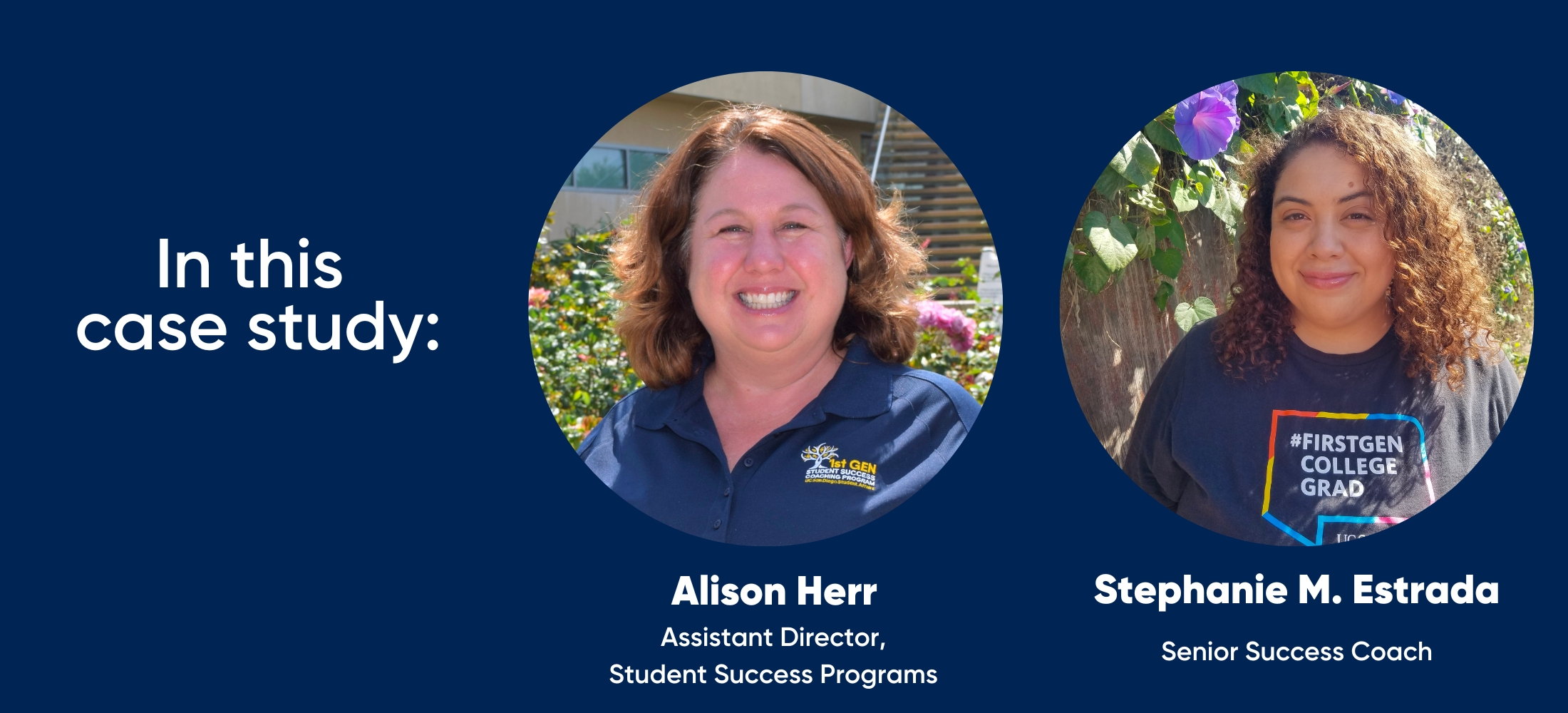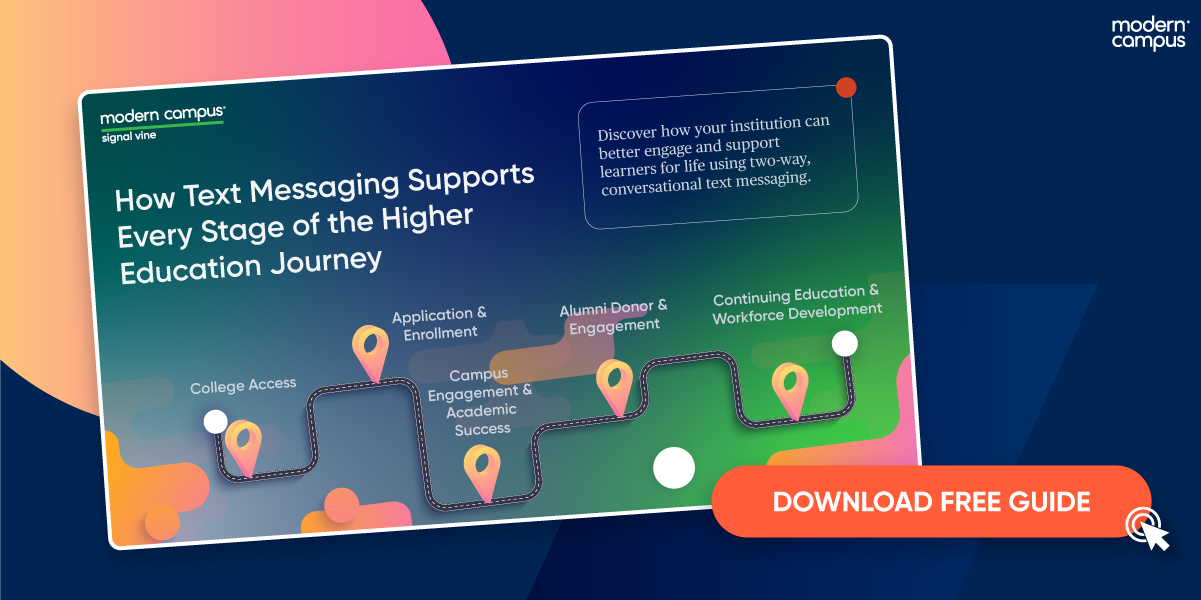About The University of California San Diego
12
divisions and schools
33,000+
undergraduate students
9,800+
students enrolled part-time
36%
first-generation students (among undergraduates)
37%
residential students (among undergraduates)
93.3%
2021 first-year retention rate

Adopting Modern Campus Message has made a huge difference. It means we can do outreach to students really, really quickly and build one-on-one relationships. We can get students connected with the right resources and make them feel confident and a part of a caring community during their time here.
The Challenge: Reaching Modern Learners
UC San Diego founded the Student Success Coaching Program in 2016, seeking to create a strengths-based approach to removing historical institutional barriers for first-generation college students.
The invite-only program provides cohorts of incoming and continuing first-generation students with one-on-one professional and peer coaching from their first year to graduation. Students meet with their coaches to discuss adjusting to college, leveraging campus resources, balancing family with school, managing their time and more.
At first, Success Coaches relied on emails and phone calls to reach students. But that proved not only excessively time-consuming but also ineffective.
We were using our office landlines to make calls, based on the phone numbers admissions had given us. We got a lot of voicemails and wrong numbers. We spent about five full work days doing little else, and we had very little success.
The team considered establishing phone numbers with Google Voice in order to text students—as other UC San Diego departments had tried— but they discovered that the service wasn’t fit for bulk messaging. They could only message a few students at once, and messages sent too frequently would get marked as spam.
They needed a better system: one that would save staff time, meet FERPA standards, target the right students and allow for a mix of bulk outgoing messages and personalized one-to-one responses.
They found all that and more in Modern Campus Message.
The Growth of UC San Diego’s Student Success Coaching Program with Message
In 2016, UC San Diego invited 425 first-year students to participate in its inaugural Student Success Coaching Program. The next year, they invited the same number of first-year students to join the existing group, thereby doubling their total reach.
And in 2020, UC San Diego was able to invite more first-year students than ever before to join the Student Success Coaching Program—a smart way to combat the challenges of connecting with students remotely during the onset of the COVID pandemic.
All told, from 2016 to 2023, the number of participants has more than quadrupled! The program comfortably serves more than 1,800 first-gen students.
The tremendous growth wouldn’t have been possible through email, phone calls or in-person meetings alone. Students are busy and understandably overwhelmed by the number of people trying to reach them. But text messaging cuts through the noise, empowering UC San Diego coaches and students to connect and maintain compelling conversations all year round.
The Advantages of Two-Way Conversational Texting
Today’s students want college and university staff to meet them in their existing communication spaces: text messaging. Message enables exactly that, with all of its features purpose-built for higher education.
We see a lot higher engagement with our texts versus our emails and even our one-on-one meetings. Students may not meet with us as often as we’d like, but they'll respond via text, which has been great.
Coaches’ favorite benefits of Message’s unique two-way conversational messaging approach include:
Continuous Engagement
Texting keeps students and coaches connected all year round, allowing trust to build naturally and the benefits of coaching to extend far beyond in-person meetings.
24/7 flexibility
Students can text their coaches anytime a question or concern arises, without worrying about disrupting that coach’s personal life. Staff only see new messages via Message during business hours.
Quick Responses
Staff can quickly survey students, offer last-minute opportunities that arise, inquire about a student’s progress with a task and get answers to yes-or-no questions.
Deadline reminders & time-sensitive information
Texting is the coaches’ most reliable way of delivering information to students as they need it, when they need it. Students often don’t check their emails until hours or days after a message is sent, but they typically see texts immediately.
Resource establishment
By texting students early into their time at UC San Diego, coaches quickly establish themself as a friendly, go-to resource.
During move-in, I sent my cohort a quick text letting them know that I was in the office if they wanted to stop by and say hi. And one student came in literally five minutes later, saying ‘My parents dropped me off. Now what? What do I do now that I'm here?’ He ended up being engaged with the program throughout his entire time at UCSD with great questions. When he graduated, he told me ‘Honestly, if you hadn't just sent me the text, I would've just stayed alone in my room.
Meeting reminders and checks
Message helps staff reach students after the start of a scheduled meeting. They can reassure students who are running a few minutes late, give lost students directions to their office or offer to reschedule.
Meeting follow-up
Message makes it easy for staff to schedule follow-up messages after in-person meetings. For example, if a student shares during a meeting that they’re nervous about an upcoming midterm, the coach can schedule a “good luck” text to go out the morning of the exam.
COVID connections
Texting allowed the coaching program to continue during pandemic lockdowns, giving students familiar staff to turn to from their phones.
Message customization
Message enables coaches to enhance text messages with pictures, links, fliers and more, enabling students to directly access the information they need. Plus, emojis help coaches express their personalities and set a conversational tone. 😊
I love that we can add images. Sometimes we'll just add fliers to liven up a message, and we use emojis all the time to convey our excitement or empathy without words. Or we’ll even send photos of ourselves. ‘Hey, here's a picture of me; I'm a real person.’ That's a really nice feature.
Meeting extension
Coaches don’t always have time to cover every available resource during their in-person meetings with students. But they can use texting to follow up—such as providing instructions for submitting a form or sharing more details about an event. Coaches may also ask students to reflect on given advice and text their thoughts within a few days—no need to schedule an additional meeting.
General check-in
Coaches will often send students general open-ended questions, inquiring about the student’s well-being. Students often appreciate such messages as a chance to boast about successes, express a concern or share a challenge.
Urgent responses
Texting has occasionally alerted coaches to a student in crisis: a UC San Diego student who is facing an emotional, mental or academic challenge they’d like help with immediately. Depending on the student’s preferred communication method, they might continue texting the coach or a coach might offer to hop on a quick Zoom call outside of the hours available through the usual booking method.
By cleverly building students’ trust, offering reliable responses and connecting students to the right resources, UC San Diego is helping first-generation learners feel confident and connected in order to persist, graduate and thrive.
Even students who don’t often respond to incoming texts from their coaches have expressed appreciation for the level of care.
I've gotten some handwritten thank-you notes from students, mostly noting how nice it is to have a human on campus whom they know really cares about them and isn’t just checking on their grades or course registration. Those cards were really touching, but several were also big surprises because they weren’t from students who came into the office a lot. They just felt really connected with us through our outgoing texts.
Discover additional ways you can use text messaging to connect students with campus resources, extend staff resources and boost retention—and how doing so fits into the entire learner journey—in our free guide:
UC San Diego's Favorite Features
Personalized Student Outreach
Message Calendar
Response Tracking
Easily schedule your messages to go out at the exact day and time you want. The user-friendly Message Calendar also allows you to manage everyday communications with students, coordinate campaigns across offices and avoid sending recipients too many messages at one time.
By building targeted communication to segmented audiences—such as first-year students, Biology majors, work-study participants or commuters—you’ll always hit the right mark with the right recipients. Integrating Message with your CRM or SIS data makes it easy.
Send check-in messages, provide personalized support and cultivate lasting relationships with students to encourage their co-curricular engagement and support their holistic success.
About Modern Campus
Modern Campus empowers 1,700+ higher education institutions to attract, engage, and retain learners for life with software solutions that enable a modern student experience.
The Modern Campus learner-to-earner lifecycle platform powers solutions for web content management, conversational text messaging, catalog and curriculum management, career pathways, student engagement and development, and non-traditional student management. The result: innovative institutions engage their modern learners for life, while providing modern administrators with the tools needed to streamline workflows and drive high efficiency.
Learn how Modern Campus is leading the modern learner-to-earner movement at moderncampus.com and follow us on LinkedIn.
